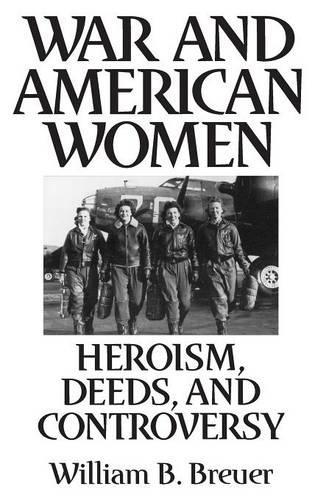
War and American Women: Heroism, Deeds, and Controversy
(Hardback)
Publishing Details
War and American Women: Heroism, Deeds, and Controversy
By (Author) William B. Breuer
Bloomsbury Publishing PLC
Praeger Publishers Inc
11th February 1997
United States
Classifications
Tertiary Education
Non Fiction
Warfare and defence
History of the Americas
355.0082
Physical Properties
Hardback
280
Description
During the Persian Gulf War of 1991, Americans back home held television-spawned images of military women (there were 37,000 of them) garbed in camouflage uniforms and steel helmets and thought that these women had actually been engaged in frontline combat instead of in support roles in which they performed admirably and with courage. Even before the women were brought back, demands were made by feminist groups and their supporters in Congress and the media to remove all restrictions barring females from direct combat. A heated controversy erupted which still continues today. Many believe that the suicide of Admiral Jeremy Boorda in 1996 was the result of his being caught in the middle of this bitter dispute. The story of the deeds and heroism of American women in the armed forces began in World War I when thousands of females volunteered to serve their country, mainly as Army nurses. They were pioneers, treading unknown paths. For their efforts, these women were targets of gossip back in their home towns, branded as "camp followers" and as having loose morals. Since that time, some 3.5 million American women have served in support roles or as spies, guerillas and war correspondents. Most of their heroics and deeds have gone unreported and unacknowledged, even though many have been killed or wounded in the line of duty. In World War II, some 350,000 American women volunteered for duty in the Women's Auxillary Corps, the Navy WAVEs, the Coast Guard SPARs, the female Marines, the nurse corps and the WASPs. Women served in the Korean War, the Vietnam War and during the Panama incursion. Opportunities for women in the armed forces increased in 1973 when the draft of men was abandoned and the All-Volunteer Force was created. Eventutually females reached general and admiral rank. However, the intense wrangling over women in combat continues to the present time. This book tells the whole story, focusing on human drama.
Reviews
Breuer's book brings to life the stories of ordinary and extraordinary women and recounts the largely unreported and unacknowledged acts of heroism in a manner both vivid and compelling.-Choice
Readers searching for an overview of this subject would do well to delve into this latest in a long string of military histories from Normandy assault veteran Breuer.... In an evenhanded presentation, Breuer gives examples in which both women and the military have been ill served during recent controversial episodes....it's a substantive work that makes a genuine contribution to an underreported facet of military, and American, history.-Publishers Weekly
"Breuer's book brings to life the stories of ordinary and extraordinary women and recounts the largely unreported and unacknowledged acts of heroism in a manner both vivid and compelling."-Choice
"Readers searching for an overview of this subject would do well to delve into this latest in a long string of military histories from Normandy assault veteran Breuer.... In an evenhanded presentation, Breuer gives examples in which both women and the military have been ill served during recent controversial episodes....it's a substantive work that makes a genuine contribution to an underreported facet of military, and American, history."-Publishers Weekly
Author Bio
WILLIAM B. BREUER is a decorated combat veteran of World War II who landed with the first assault waves in Normandy. He is one of today's most popular military historians and the author of 25 books since 1982. Ten were selections of the Military Book Club, six translated into foreign languages. A first class author who writes with an emphasis on human drama, says The Wall Street Journal.
